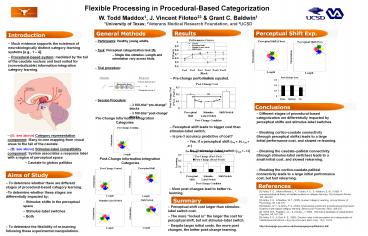Flexible Processing in Procedural-Based Categorization
1 / 1
Title:
Flexible Processing in Procedural-Based Categorization
Description:
3 100-trial 'pre-change' blocks. 3 100-trial 'post-change' blocks. Stimulus Response Feedback ' ... Pre-change performance equated. More post changes lead to ... –
Number of Views:11
Avg rating:3.0/5.0
Title: Flexible Processing in Procedural-Based Categorization
1
Flexible Processing in Procedural-Based
Categorization
W. Todd Maddox1, J. Vincent Filoteo23 Grant C.
Baldwin1 1University of Texas 2Veterans Medical
Research Foundation, and 3UCSD
Perceptual Shift Exp.
- Participants Healthy young adults.
- Task Perceptual categorization task 5.
- Single line stimulus. Length and orientation
vary across trials. - Trial procedure
- Session Procedure
- 3 100-trial pre-change blocks
- 3 100-trial post-change blocks
- Much evidence supports the existence of
neurobiologically distinct category learning
systems e.g., 1 4. - Procedural-based system mediated by the tail of
the caudate nucleus and best suited for
(nonverbalizable) information-integration
category learning.
Stimulus Response Feedback
- Pre-change performance equated.
"Correct, that was an A" or "Wrong, that was
an A"
A
B
- Different stages of procedural-based
categorization are differentially impacted by
perceptual shifts and stimulus-label switches. - Breaking cortico-caudate connectivity (through
perceptual shifts) leads to a large initial
performance cost, and slowed re-learning. - Breaking the caudatepallidal connectivity
(through stimulus-label switches) leads to a
small initial cost, and slowed relearning. - Breaking the cortico-caudate-pallidal
connectivity leads to a large initial performance
cost, but fast relearning.
Pre-Change Information-Integration Categories
- Perceptual shift leads to bigger cost than
stimulus-label switch. - Is pre-3 accuracy predictive of cost?
- Yes, if a perceptual shift (rPS .55, rSS
.41) - No, if stimulus-label switch (rSLS -.14)
- (A see above) Category representation
component Many-to-one mapping from visual areas
to the tail of the caudate. - (B see above) Stimulus-label compatibility
component System associates a response label
with a region of perceptual space - Caudate to globus pallidus
Post-Change Information-Integration Categories
- To determine whether there are different stages
of procedural-based category learning. - To determine whether these stages are
differentially impacted by - Stimulus shifts in the perceptual space
- Stimulus-label switches
- Both
- To determine the flexibility of re-learning
following these experimental manipulations.
- More post changes lead to better re-learning.
- 1 Ashby, F. G., Alfonso-Reese, L. A., Turken,
A. U., -Waldron, E. M., (1998). A
neuropsychological theory of multiple systems in
category learning. Psychological Review, 105,
442-481. - 2 Ashby, F. G., Maddox, W. T. (2005). Human
Category Learning. Annual Review of Psychology,
56, 149-178. - 3 Maddox, W. T., Ashby, F. G. (2004).
Dissociating explicit and procedural-learning
based systems of perceptual category learning.
Behavioural Processes, 66(3), 309-332. - 4 Smith, E.E., Patalano, A.L., Jonides, J.
(1998). Alternative strategies of
categorization. Cognition, 65, 167-196. - 5 Ashby, F. G., Gott, R. E. (1988). Decision
rules in the perception and categorization of
multidimensional stimuli. J Exp Psychol Learn Mem
Cogn, 14(1), 33-53. - http//homepage.psy.utexas.edu/homepage/group/Madd
oxLAB/
- Perceptual shift cost larger than stimulus-label
switch cost. - The more locked in the larger the cost for
perceptual shift, but not stimulus-label switch. - Despite larger initial costs, the more post
changes, the better post-change learning.































